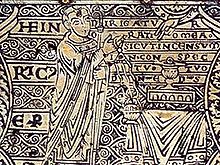Heinrich II. Von Werl
Heinrich II. Von Werl (* around 1050; † October 14, 1127 ) was bishop of Paderborn from 1084 to 1127 .
Live and act
Heinrich came from the family of the Counts of Werl and was the brother of Counts Ludolf von Werl and Konrad von Werl-Arnsberg . Because of its handsome figure, it was also called an ermine . As a later son, Heinrich was intended for a career in the church. He became provost of the monastery of St. Simon and Judas in the imperial palace in Goslar .
Like his family, he was part of the emperor during the reign of Henry IV . Heinrich sold part of his inheritance to his brother Konrad in order to have enough funds to acquire the office of bishop in Paderborn. Mediated by his brother, the emperor and the antipope Clemens III recognized him . as bishop in 1084, without the cathedral chapter being involved. This had now been Heinrich Assel chosen by the Pope Gregory VII. Had been recognized. Based not least on the military might of his family, Heinrich succeeded in asserting himself against the competitor in violent clashes.
Later, too, he was temporarily deposed several times in connection with the political events in the empire. However, he was ultimately able to assert himself.
It is of regional historical importance that under Heinrich the bailiwick rights over the diocese of Paderborn passed from his family to the von Schwalenberg family. In the documents, Heinrich is referred to as the first bishop of Paderborn as Princeps.
Heinrich von Werl was considered to be philanthropic and an eager clergyman. He particularly emerged as a patron of the Abdinghof Monastery and the Helmarshausen Monastery .
Heinrich donated a portable altar for the Paderborn Cathedral and had himself depicted on the cover plate together with his predecessor Meinwerk von Paderborn . The altar is considered a key work by Rogerus von Helmarshausen . With him the art of the Romanesque began to establish itself in north-west Germany. This foundation not only served pious purposes, but the imperial bishop placed himself in a line of continuity with Meinwerk and used the work of art for legitimation.
Remarks
- ↑ on the situation of the diocese of Paderborn during the investiture dispute (on canossa2006.de)
- ↑ On the history of the portable altar (on cannossa2006.de)
literature
- Hermann Bollnow : The Counts of Werl. Genealogical research on the history of the 10th to 12th centuries. Ostsee-Druck und Verlag, Stettin 1930 (Greifswald, Phil. Diss. Of May 13, 1930), ( partial online edition ).
- Karl Féaux de Lacroix : History of Arnsberg. HR Stein-Verlag, Arnsberg 1895, p. 11f. ( Digitized edition ).
- Johann Suibert Seibertz : State and legal history of the Duchy of Westphalia. Volume 1, Section 1: Diplomatic family history of the old Counts of Westphalia zu Werl and Arnsberg. Ritter, Arnsberg 1845, p. 66ff., Digitized edition .
- Friedrich W. Ebeling: The German bishops until the end of the sixteenth century. Presented biographically, literarily, historically and in terms of church statistics. Volume 2. Wigand, Leipzig 1858, p. 348.
Web links
| predecessor | Office | successor |
|---|---|---|
| Heinrich I of Assel |
Bishop of Paderborn 1084–1127 |
Bernhard I of Oesede |
| personal data | |
|---|---|
| SURNAME | Heinrich II. Von Werl |
| BRIEF DESCRIPTION | Bishop of Paderborn |
| DATE OF BIRTH | around 1050 |
| DATE OF DEATH | October 14, 1127 |
